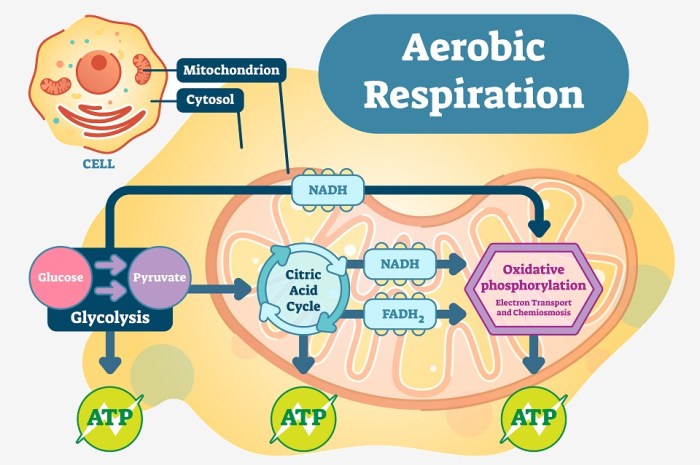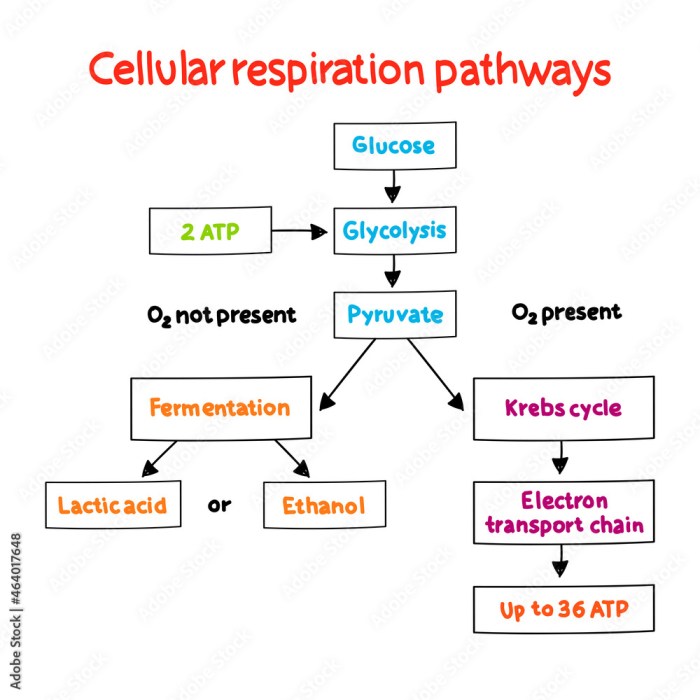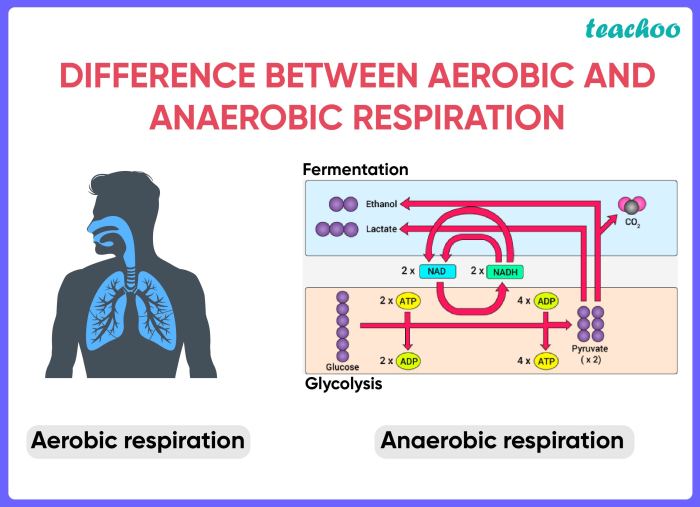The Aerobic Cellular Respiration Concept Map: Unveiling the Powerhouse of Life introduces a captivating journey into the intricate workings of aerobic cellular respiration, a fundamental process that sustains all living organisms. Through a comprehensive exploration of its stages, energy production, regulation, and applications, this concept map unravels the secrets of life’s energy engine, providing a profound understanding of its significance in the biological realm.
Aerobic cellular respiration, a complex biochemical pathway, harnesses the power of oxygen to generate energy in the form of ATP, the universal energy currency of cells. It consists of three primary stages: glycolysis, the Krebs cycle, and the electron transport chain, each playing a crucial role in extracting energy from glucose, the primary energy source for most organisms.
Aerobic Cellular Respiration

Aerobic cellular respiration is a fundamental metabolic process in living organisms that converts biochemical energy from nutrients into adenosine triphosphate (ATP), the cell’s main energy currency. It occurs in the presence of oxygen and involves a series of chemical reactions that release energy in a controlled manner.
Aerobic cellular respiration is essential for sustaining cellular activities and maintaining homeostasis.
Stages of Aerobic Cellular Respiration, Aerobic cellular respiration concept map
Aerobic cellular respiration comprises three main stages: glycolysis, Krebs cycle, and electron transport chain. Glycolysis:Glycolysis is the initial stage that occurs in the cytoplasm. It involves the breakdown of glucose, a six-carbon sugar, into two molecules of pyruvate, a three-carbon compound.
This process releases a small amount of energy, which is captured as two molecules of ATP and two molecules of NADH, an electron carrier. Krebs Cycle (Citric Acid Cycle):The Krebs cycle takes place in the mitochondrial matrix. Pyruvate molecules from glycolysis are further oxidized, releasing carbon dioxide as a waste product.
This process generates additional ATP, NADH, and FADH2, another electron carrier. Electron Transport Chain:The electron transport chain is a series of protein complexes located in the inner mitochondrial membrane. NADH and FADH2 donate their electrons to the electron transport chain, which undergoes a series of redox reactions.
As electrons pass through the chain, their energy is used to pump hydrogen ions across the membrane, creating a proton gradient. This gradient drives the synthesis of ATP through ATP synthase.
Energy Production
Aerobic cellular respiration generates ATP through the electron transport chain. As electrons flow through the chain, their energy is used to pump hydrogen ions across the mitochondrial inner membrane, creating a proton gradient. This gradient drives the synthesis of ATP through ATP synthase, an enzyme that utilizes the proton gradient to phosphorylate ADP to ATP.
Regulation of Aerobic Cellular Respiration
Aerobic cellular respiration is tightly regulated to ensure that energy production matches the cell’s needs. Key regulators include oxygen availability, ATP levels, and feedback inhibition. Oxygen Availability:Oxygen is the final electron acceptor in the electron transport chain. If oxygen is not available, aerobic cellular respiration cannot occur, and the cell must switch to anaerobic respiration.
ATP Levels:ATP levels can inhibit glycolysis and the Krebs cycle. When ATP levels are high, the cell reduces energy production to avoid overproduction. Feedback Inhibition:The end products of aerobic cellular respiration, such as ATP and NADH, can inhibit earlier steps in the process to prevent overproduction.
Comparison to Anaerobic Cellular Respiration
Anaerobic cellular respiration occurs in the absence of oxygen. It is less efficient than aerobic cellular respiration and produces fewer ATP molecules. Anaerobic cellular respiration produces lactic acid in animals and ethanol in plants as waste products.
Applications
Aerobic cellular respiration has practical applications in medicine and biotechnology. Medicine:Understanding aerobic cellular respiration can help diagnose and treat diseases related to energy metabolism, such as mitochondrial disorders. Biotechnology:Aerobic cellular respiration is used in industrial processes, such as the production of biofuels and pharmaceuticals.
FAQ Section: Aerobic Cellular Respiration Concept Map
What is the primary function of aerobic cellular respiration?
Aerobic cellular respiration’s primary function is to generate energy in the form of ATP, the universal energy currency of cells.
How many stages are involved in aerobic cellular respiration?
Aerobic cellular respiration consists of three main stages: glycolysis, the Krebs cycle, and the electron transport chain.
What is the role of oxygen in aerobic cellular respiration?
Oxygen acts as the final electron acceptor in the electron transport chain, facilitating the production of ATP.


